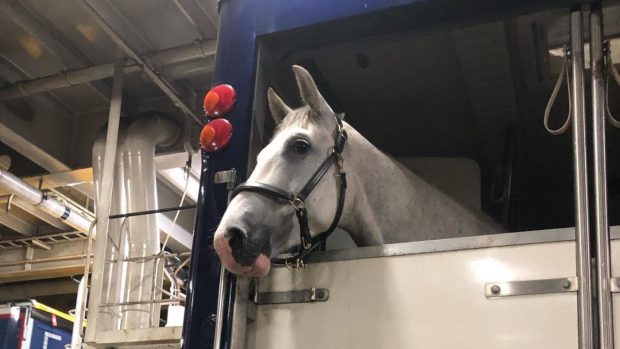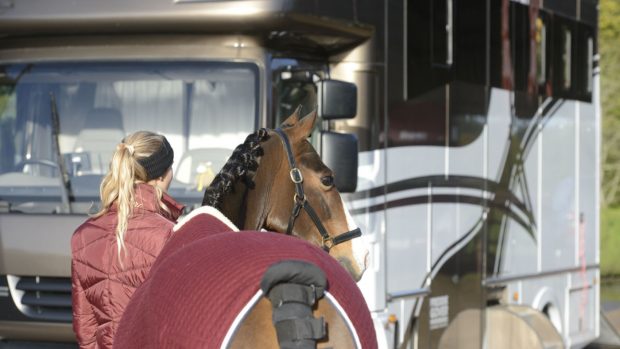Travelling goes hand in hand with owning horses, but a bad journey can have dire consequences. Here are 14 ways to make transporting your horse as stress-free as possible for both of you…
- Take the time to pack everything you need – both for the journey and in case of emergency – before you load the horse. This will ensure he doesn’t spend any more time standing on the box than he needs to. View our packing checklist.
- On long journeys of more than three hours, pull over and untie the horse so that he can lower his head and drain mucus from his airways. This helps decreases the risk of pneumonia or shipping fever.
- Use appropriate protective travel boots or bandages – a lot of damage can be done by hooves and legs becoming trapped under a partition or kicking at the sides, but make sure your horse is comfortable and confident wearing them. A tail bandage or guard will protect the tail from being rubbed.
- Avoid over-clothing your horse – they do not need the same thickness of rugs they would standing in the stable. They have a wider thermoneutral zone than humans, which means they don’t feel the cold as much as we do. Too cool is preferable to too warm, especially given that they expend energy while keeping their balance during transit, and trucks can often get quite hot with livestock on board, even on winter days.
- Keep your horse’s management as normal as possible. For example, using your own hay and feed means there is no sudden change in diet. Offer water at regular intervals, too.
- Take out emergency rescue cover that includes horses and store the membership card in your vehicle – and make sure you’re confident in what to do if you breakdown.
- Make sure your horse’s passport is on board as it’s illegal to transport your horse without it.
- Ensure that you carry extra hay and water for your horse, plus warm clothes and refreshments for you, just in case.
- Work out where veterinary practices are along your route. Mark them on a map and record their contact details.
- Consider leaving earlier and stabling overnight if you can – a long, hot and bumpy ride will takes its toll and tire your horse. The quality of driving effects the effort a horse must make to maintain balance, so drive smoothly and at reasonable speeds.
- Allow plenty of time to load and don’t rush, as this can be a stressful part of travelling for horses. Always make sure you stay calm, too, and never get cross. If your horse is young or inexperienced, practise loading into your vehicle before he is due to travel. Park the lorry or trailer next to a wall, to help channel him into the box.
- Plan frequent rest breaks to offer water and hay from the ground, again allowing the horse to stretch his head down. Dehydration can trigger respiratory problems and increase the risk of colic.
- Allow adequate ventilation and cleaning out the vehicle regularly en route to prevent respiratory problems. Avoid dusty hay or bedding, too.
- Always use a well-fitting headcollar, with the lead rope tied using a quick-release knot to a piece of baler twine. This will allow quick and easy release in an emergency. A leather headcollar or other type of safety headcollar is recommended as these will break if the horse pulls back.

Travelling horses: the right kit and equipment for your horse
It’s important that your horse is used to all the kit he might be wearing while travelling. If you dress him up for the first time moments before you take him to his first show, he may object to the new sensation of long travel boots or an unfamiliar tail guard. This will add to stress levels, so try bits on gradually in the days leading to his first outing:
- Travel rugs: as mentioned above, horses do get hot while travelling, so beware of over-rugging as this may cause him to overheat. A wicking cooler rug is a useful addition to your horse’s wardrobe, to keep him at a consistent temperature on colder days and to help protect him from rubbing on the partition. It will also come in handy while he is standing around at the competition. Always rug up according to the season, temperature and your horse’s coat condition. Check him after 20 minutes to ensure he is comfortable.
- Headcollar and lead-rope: ideally the headcollar will be made from leather, as this breaks under pressure, or another form of safety headcollar. A leather headcollar also looks smart on an outing. Take a spare headcollar and rope, in case either does break.
- Travel boots: to protect the horse’s legs when he’s being loaded, unloaded and during transit. These are designed to cover a large part of the horse’s legs, protecting them from knocks and scrapes, and absorbing shock. Make sure you choose boots made of breathable material so the horse’s legs do not overheat.
- Tail protection: to prevent the tail being rubbed. You can either use the traditional elasticated bandage, or a tail guard or bag. Not only do these help protect the tail from damage, but they keep it clean during transit.
- Poll guard: to protect the top of the horse’s head from injury if he bangs the roof – especially for the taller horse.
- Water carrier and bucket: however short the trip, always take at least a full 25-litre carrier full of water. Even if you are only planning to drive a few miles down the road, and the horse will not be exercising, you never know when you might break down and need to offer water.
- Haynet, plus spare hay or haylage if required: again, if it’s just a short journey and you don’t think your horse needs the feed, it will be essential if you break down. Also, pecking at a bit of hay can help soothe a nervous traveller. You can get small-holed nets if you don’t want him chomping down too much.
- Horse’s passport: it’s illegal to travel without it
- Equine first-aid kit: always handy to have on the road and at your destination.
Equipment for the lorry
Just as when you are driving just your car, you need to make sure your lorry or trailer is kitted out with all the essentials.
- Chargers or spare battery for your phone
- Decent spare tyres for the lorry, or both car and trailer in the case of towing, plus wheel jack.
- Human first-aid kit
- Fire extinguisher
-
Toolkit – you can get emergency kits that contain all the items you’ll need if you break down. Or you can put the kit together yourself, including:
- Warning triangles
- High-vis vest
- Tow rope
- Emergency blanket
- Emergency hammer
- Screwdriver
- PVC tape
- Jump leads – even if you don’t feel confident enough to be able to use them, at least you can ask someone to help you
- Fuses and spare bulbs
- Tyre pressure gauge and pump
- Your important documents, such as insurance certificate, MOT certificate, driving licence and vehicle logbook. It is not a legal requirement to have these in the vehicle while travelling, but you may be asked by the police to produce them within seven days.
- Membership card or details of breakdown cover
- Contact numbers for vets en route
- Waterproofs
- Torch
- Map
- Sweets – something to keep you going if your journey ends up taking a lot longer than planned.
- Skipping-out kit and manure bag or trug: clean up after your horse!

Travel in style in one of these smart sets of travel boots

9 travel rugs worth adding to your horse’s wardrobe
Are you on the search for a new travel rug for your horse? Check out this selection of the best

Travelling horses in the heat — and what to do if you get stuck on the motorway

Subscribe to Horse & Hound this spring for great savings
Horse & Hound magazine, out every Thursday, is packed with all the latest news and reports, as well as interviews, specials, nostalgia, vet and training advice. Find how you can enjoy the magazine delivered to your door every week, plus options to upgrade your subscription to access our online service that brings you breaking news and reports as well as other benefits.





